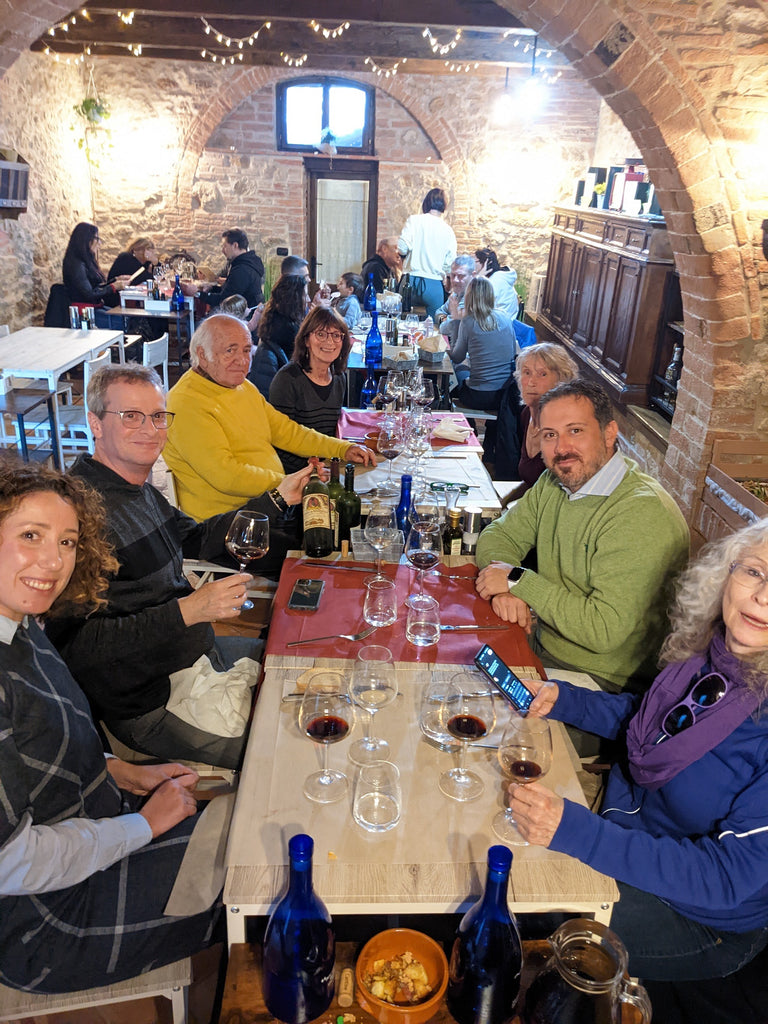Our tasting impressions
At a lunch with the Innocenti's, the Guru was reduced to tears of sheer ecstasy, as he drank Vittorio's 1985 Vino Nobile. The 2016 Vino Nobile, relatively still an infant, may one day surpass that amazing '85. Despite its undoubted long-term trajectory, it is joyful now. Just know that your last glass will be more transcending than the first. Drink this too fast and you might wonder what we are talking about! With ample air it is apparent that this is the whole package: depth, complexity, purity, structure, energy... Trust us and get as much as you can. Following this wine over the years (decades) will more than justify the modest investment.
About this wine
Vino Nobile di Montepulciano DOCG is, along with Brunello and Chianti Classico, the epitome of Sangiovese-based wines in Tuscany. At their best, Vino Nobile combine the power of Brunello with the finesse of Chianti.
Innocenti’s Vino Nobile is a very traditional blend of predominantly Sangiovese (technically Prugnolo Gentile, the name for its local sub-variety) with some Canaiolo and Colorino. The vines were planted in 1998 in sandy soil at about 350 meters facing southwest.
They perform double cluster thinning (green harvest) before a manual harvest. Any grapes that are not to their standards are sold. The harvest is entirely manual. The Sangiovese is destemmed (the tannins are too green) and the other varieties are used whole-cluster. Then, all the grapes are vinified together.
Fermentation is in steel tanks with natural yeasts and maceration, on the skins, lasts 12-15 days. They perform délestage (draining the wine off the must and then gently pumping it back over). The caps are punched down. It ages 30 months (only 24 is required) in French and Slavonian oak barrels then passes through a wide-grain filter for bottling. It is released years later than most Vino Nobile.
About the grape blend
Sangiovese is the most planted grape in Italy and is the dominant grape throughout the central part of the country. There are many variants and even different names like Prugnolo Gentile, Brunello, Sangioveto and Morellino.
The grapes are dark and thick-skinned, slow-ripening, acidic and tannic. Like Pinot Noir, Sangiovese is heavily influenced by its terroir and similarly can be quite transparent in its differences from place to place.
Canaiolo and Colorino are traditional blending grapes for Tuscan Sangiovese. Colorino is sparsely used today. Apropos of the name, its deep pigmentation mostly adds color to the blend, but also tannins. Canaiolo balances the other two with softness and imparts graceful herbal flavors.
About the vintage
2016 is a modern day classic vintage in Tuscany. A near perfect growing season that started slowly, warmed up nicely through the summer, and ended with a classic autumn. Ample warm days and cool nights produced a slightly reduced crop of wines that combine the richness of low-yields with the near perfect balance of mature tannins and bright acidity.
On your table
Gorgeous with these ribs and these birds. We suggest a large white wine glass (one with nice height but fairly vertical shape) and enjoy this wine at cool cellar temperature.
Vittorio Innocenti, a former philosophy teacher, started producing wine from his family's vineyards with the 1978 vintage from his 13th century cellar in Montefollonico. There are 32 hectares of vines in Montepulciano and Montefollonico but only 12 are planted with vineyards of up to 80 years old. The vista views from the back patio are incredible.
Today, Vittorio's son Tommaso and his partner Vincenza (aka Nancy) handle most of the work. But Vittorio is the keeper of the intellectual capital for all seven wines - in particular both versions of Vin Santo. In total, they produce about 35,000 bottles annually.
The Innocentis are a gracious, wonderful family. The Guru has known them longer than any other wine producer. He admires their intense commitment to producing the highest quality wines - taking as much pride in their most modest offering as they do in their top bottling.
VDLT is the only North American source for these extraordinary wines that are released much later than most top estates in the appellation. The Vino Nobile, Riserva and Acerone are capable of long and magnificent aging. In the photo to the right, we enjoyed a 1985, 1988 and 1993 at a recent lunch. Their freshness and vibrancy belied their age.
